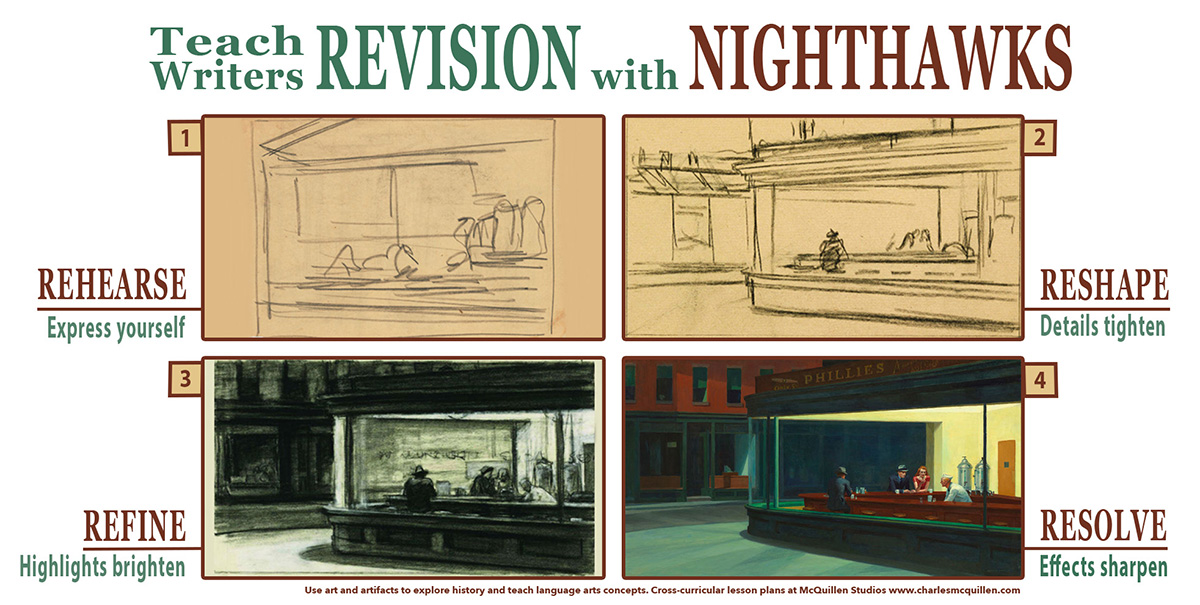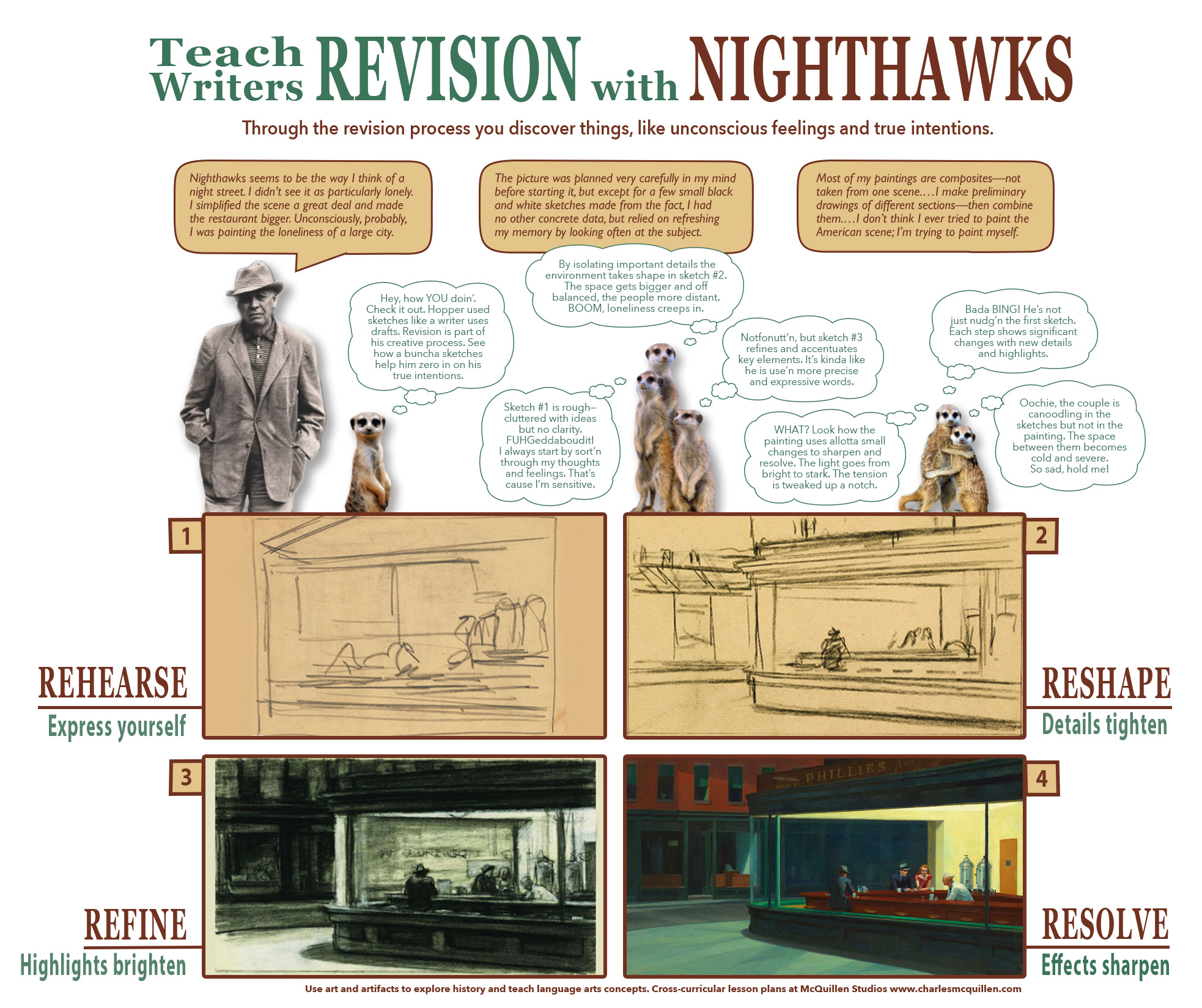Edward Hopper’s preliminary sketches for Nighthawks offer mentor art for teaching students the revision process.
Mentor texts have long been used to model writing techniques. Mentor art can likewise be used to inspire, teach, and refine student writing. Mentor art has the added benefit of addressing diverse learning styles and providing visual support to language learners. Consider introducing your students to the revision process with Edward Hopper’s Nighthawks.
It is beneficial to let students experience a work of art on its and their own terms before using it as mentor art. This link offers teaching moves and language for introducing students to Edward Hopper’s Nighthawks. This image from the Art Institute of Chicago Building lets you magnify the painting and see exquisite detail. Thank you Art Institute of Chicago!
Project the image above and have students respond in small groups to the three discussion prompts and report back. Click on the image to expand. Download the pdf below.
#1: Edward Hopper used quick sketches to catch fleeting observations. Through a series of sketches he zeroed in on a composition that fittingly evoked the intangible feeling or mood he hoped to capture. Describe the visual progression of the sketches and how they lead to the painting “Nighthawks.” Note especially how the light, space, and figures are composed.
Turn, Talk, and Report Back (Possible answers)
- Sketch 1 is rough but suggests the coffee urns and the people. The interior of the diner is balanced and consumes the composition. The horizontal lines of the counter and window are shown. The grouping of the figures is very intimate and compact.
- Sketch 2 draws back with a third of the composition now revealing the street around the diner. The space is bigger and figures are smaller and more distant. The composition is increasingly imbalanced. While the couple remains compact the single man grows more isolated. More details, such as the stools and window frames, are shown and the beginnings of shadows appear on the street.
- Sketch 3 shows distinct architectural features and light sources. The surrounding darkness heightens the imbalance of the composition. Chalk is used to show the light that spills out onto the street. The couple is shown as distinct figures. They turn toward and lean into each other. The man behind the counter looks down as if working with something.
- In the painting the figures are slighter and more distinct. Note the space that now separates the couple. The couple sits straight up and looks away from each other. The figure behind the counter looks up but past his customers. Minor implements and personal details are shown. The interior of the diner is more spacious. The painting now shows a sliver of ceiling and the back wall is bigger showing space around the door, adding more light to the scene. The light from the diner creates angular patterns on the street beyond.
The evolution of the composition emphasizes psychological isolation and introspection. Subtle shifts in gesture and placement show how Hopper improvised, honing in on his instinct and the feeling or mood he was striving for. As the space grows in scale, the figures become more remote and emotionally detached. The pregnant space between the couple introduces ambiguity and opens the door for alternative narratives. The composition’s growing imbalance creates a visual tension that instills a sense of unease. The dichotomy between the lighted interior of the diner and the dark street is echoed in the figures. The motionless diner inhabitants stand in contrast to the roiling introspection that is evidenced in their distant stares. The drawings focus on factual external relationships, while the painting emphasizes inner psychological feelings.
#2: Edward Hopper used sketches the way writers’ use drafts. Describe how the sketches’ visual progression could be translated into terms and concerns writers might have as they revise a piece of writing.
Turn, Talk, and Report Back (Possible answers)
- Sketch 1 is loose like a rough draft. It’s cluttered. It’s full of ideas. It’s scattered and lacks focus.
- Sketch 2 adds important details. The environment takes shape. Characters and relationships are recognizable. You can identify the beginning of a narrative.
- Sketch 3 refines and accentuates key elements. It’s like he is using more precise and expressive words. The changes instill a deeper understanding.
- In the painting the elements are sharpened, effects are heightened, issues are resolved, alternative interpretations are suggested. For example the space between the couple is pregnant with meaning and alternative interpretations. The bright light becomes stark and even oppressive.
#3: How might Edward Hopper’s creative process and the way he uses sketches to find his way inform the way you revise your writing? (Answers will vary.)
Expand your discussion with Edward Hopper and a group of meerkats. Note the meerkats are an unpredictable lot and can be a tad impetuous. Their opinions and actions are not those of this organization. Don’t blame us for what they say.
How would you use Edward Hopper’s Nighthawks to teach the revision process or other writing techniques? Extend the discussion with your comments below.
Teach-RevisionTeach-Revision-MK-handout



Comments are closed, but trackbacks and pingbacks are open.